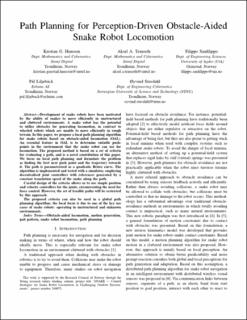Path Planning for Perception-Driven Obstacle-Aided Snake Robot Locomotion
Chapter
Accepted version

Åpne
Permanent lenke
https://hdl.handle.net/11250/2729062Utgivelsesdato
2020Metadata
Vis full innførselSamlinger
Originalversjon
10.1109/AMC44022.2020.9244366Sammendrag
Development of snake robots have been motivated by the ability of snakes to move efficiently in unstructured and cluttered environments. A snake robot has the potential to utilise obstacles for generating locomotion, in contrast to wheeled robots which are unable to move efficiently in rough terrain. In this paper, we propose a local path planning algorithm for snake robots based on obstacle-aided locomotion (OAL). An essential feature in OAL is to determine suitable push-points in the environment that the snake robot can use for locomotion. The proposed method is based on a set of criteria for evaluating a path, and is a novel contribution of this paper. We focus on local path planning and formulate the problem as finding the best next push point and the trajectory towards it. The path is parameterised as a quadratic Bézier curve. The algorithm is implemented and tested with a simulator, employing decentralised joint controllers with references generated by a constant translation speed of the snake along the path. Careful design of the criteria allows us to use simple position and velocity controllers for the joints, circumventing the need for force control. However, the set of feasible paths will be restricted by this approach. The proposed criteria can also be used in a global path planning algorithm; the local focus is due to one of the key use cases of snake robots: operating in unstructured and unknown environments.